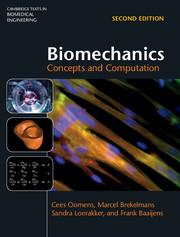Book contents
- Frontmatter
- Contents
- About the Cover
- Preface to the First Edition
- Preface to the Second Edition
- 1 Vector and Tensor Calculus
- 2 The Concepts of Force and Moment
- 3 Static Equilibrium
- 4 The Mechanical Behaviour of Fibres
- 5 Fibres: Time-Dependent Behaviour
- 6 Analysis of a One-Dimensional Continuous Elastic Medium
- 7 Biological Materials and Continuum Mechanics
- 8 Stress in Three-Dimensional Continuous Media
- 9 Motion: Time as an Extra Dimension
- 10 Deformation and Rotation, Deformation Rate and Spin
- 11 Local Balance of Mass, Momentum and Energy
- 12 Constitutive Modelling of Solids and Fluids
- 13 Solution Strategies for Solid and Fluid Mechanics Problems
- 14 Solution of the One-Dimensional Diffusion Equation by Means of the Finite Element Method
- 15 Solution of the One-Dimensional Convection–Diffusion Equation by Means of the Finite Element Method
- 16 Solution of the Three-Dimensional Convection–Diffusion Equation by Means of the Finite Element Method
- 17 Shape Functions and Numerical Integration
- 18 Infinitesimal Strain Elasticity Problems
- References
- Index
About the Cover
Published online by Cambridge University Press: 02 February 2018
- Frontmatter
- Contents
- About the Cover
- Preface to the First Edition
- Preface to the Second Edition
- 1 Vector and Tensor Calculus
- 2 The Concepts of Force and Moment
- 3 Static Equilibrium
- 4 The Mechanical Behaviour of Fibres
- 5 Fibres: Time-Dependent Behaviour
- 6 Analysis of a One-Dimensional Continuous Elastic Medium
- 7 Biological Materials and Continuum Mechanics
- 8 Stress in Three-Dimensional Continuous Media
- 9 Motion: Time as an Extra Dimension
- 10 Deformation and Rotation, Deformation Rate and Spin
- 11 Local Balance of Mass, Momentum and Energy
- 12 Constitutive Modelling of Solids and Fluids
- 13 Solution Strategies for Solid and Fluid Mechanics Problems
- 14 Solution of the One-Dimensional Diffusion Equation by Means of the Finite Element Method
- 15 Solution of the One-Dimensional Convection–Diffusion Equation by Means of the Finite Element Method
- 16 Solution of the Three-Dimensional Convection–Diffusion Equation by Means of the Finite Element Method
- 17 Shape Functions and Numerical Integration
- 18 Infinitesimal Strain Elasticity Problems
- References
- Index
Summary
The cover contains images reflecting biomechanics research topics at the Eindhoven University of Technology. An important aspect of mechanics is experimental work to determine material properties and to validate models. The application field ranges from microscopic structures at the level of cells to larger organs like the heart. The core of biomechanics is constituted by models formulated in terms of partial differential equations and computer models to derive approximate solutions.
• Main image: Myogenic precursor cells have the ability to differentiate and fuse to form multinucleated myotubes. This differentiation process can be influenced by means of mechanical as well as biochemical stimuli. To monitor this process of early differentiation, immunohistochemical analyses are performed to provide information concerning morphology and localization of characteristic structural proteins of muscle cells. In the illustration, the sarcomeric proteins actin (red), and myosin (green) are shown. Nuclei are stained blue. Image courtesy of Mrs Marloes Langelaan.
• Left top: To study the effect of a mechanical load on the damage evolution of skeletal tissue, an in-vitro model system using tissue engineered muscle was developed. The image shows this muscle construct in a set-up on a confocal microscope. In the device the construct can be mechanically deformed by means of an indentor. Fluorescent identification of both necrotic and apoptotic cells can be established using different staining techniques. Image courtesy of Mrs Debby Gawlitta.
• Left middle: A three-dimensional finite element mesh of the human heart ventricles is shown. This mesh is used to solve the equations of motion for the beating heart. The model was used to study the effect of depolarization waves and mechanics in the paced heart. Image courtesy of Mr Roy Kerckhoffs.
• Left bottom: The equilibrium equations are derived from Newton's laws and describe (quasi-)static force equilibrium in a three-dimensional continuum. See Eqs. (8.33), (8.34) and (8.35) in the present book.
- Type
- Chapter
- Information
- BiomechanicsConcepts and Computation, pp. xiii - xivPublisher: Cambridge University PressPrint publication year: 2018

